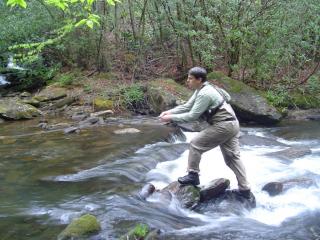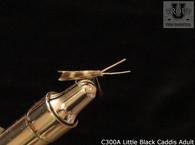
Learn how to start fly fishing for trout. This class covers the steps to take to start fly fishing, including gearing up, what's required, and what's optional.
Beginning fly fishing for trout can be a daunting task, though starting to fly fish can be simplified to the following steps. Note: See our Glossary for terms you're not familiar with. This class will point you in the right direction for getting started, but for a more comprehensive look, check out our ebook on Getting Started Fly Fishing For Trout.
1. Purchase a fly rod and reel, along with the backing, fly line, leader, and tippet. You can purchase these in our store in an inexpensive Fly Fishing Starter Kit. Purists will tell you that you need an expensive rod with just the right action, etc., but you don't need that to get started. Don't get me wrong, if you know you're going to love fly fishing, or after you've been at it a while, you will want and enjoy a Perfect Fly brand fly rod. A 5-6 weight outfit is a good choice for beginners, though you may want a different weight, depending on the flies you will be casting and the size of stream you will be fishing. Also, I recommend a relatively long fly rod (8' - 6" to 9' long), as it will keep more line out of the water. Double taper floating fly line is the most common and versatile. You will need extra leaders and tippet, as these are consummable items.
2. Most importantly, purchase quality flies. I recommend Perfect Fly brand flies, available in our store. In fact, we even created a special beginner's fly collection. Perfect Flies are the most realistic and specific flies around, and we offer in depth information on how (and where) to fish them. Study this information carefully, use Perfect Flies, and you will catch more trout. You may be tempted to purchase low - quality, less expensive flies, but this is a big mistake. The fly is the part of your gear that the fish actually get to inspect, so they need to be good. Using cheap flies is the equivalent of putting low quality, bald tires on a nice car. For the beginner, I recommend using dry flies, as they are more fun, and I believe, easier to learn to use. Later, you can graduate to nymphs (which are probably the most effective, but most difficult to fish) and streamers.
3. Purchase the ancillary gear. Required items include good wading boots (felt soled boots have great rock-gripping capability, but they have fallen out of favor to some degree due to their tendency to spread pest problems), a fly fishing vest or other item to carry your gear, a well stocked fly box, needle nose pliers,and fingernail clippers. Recommended items include waders (These are actually required, if fishing in cold months and/or deep water. We recommend the breathable type for maximum comfort over a full day's fishing.), polarized sunglasses, and a Hands Free Rod Holder.
4. Choose a stream to fish. I recommend an easily reached and navigated stream to begin with. Small streams are often good because the trout are easier to locate, and often less picky, but you may prefer large rivers or ponds or lakes. If you're interested in small streams, see our ebook Small Stream Trout Fishing. Sometimes we offer this book for free by filling out our online survey, so be sure to look for it! Delayed Harvest streams, in states that offer this designation, are often good choices. Also, if you can fish a stream that has limited obstructions in the water, and on the shore, you will save yourself much frustration. Be aware of fluctuating water levels when fishing tailraces. You can search state fishing regulations, websites (especially see our Streams section), and state and national parks for streams to fish. We offer an ebook that covers trout fishing in North Carolina, a book and DVD set that cover the Great Smoky Mountains National Park, and a DVD set that covers Yellowstone National Park. Also, network with other fishermen, such as visiting our Facebook Page, Twitter Page, or joining Trout Unlimited. Finally, feel free to Contact Us with additional questions.
5. Do your homework, including researching state fishing regulations, guides, weather, and stream access. Practice casting on a lawn or other open area prior to visiting the stream.
6. Have the right state of mind. Remember to enjoy the scenery, take it slow, relax, and be patient. And, most importantly, be safe.
Check out troutu.com's additional related classes, such as What To Take, Basic Knots, Catch And Release, Fly Rods And Reels, Fly Lines, and Fly Casting. Also, see our numerous Fly Fishing DVD's covering a variety of trout fishing topics, including Getting Started Fly Fishing Basics.
Learn the insects and their life cycles for the area of the country you will be fishing, and implement your knowlege while fishing.





